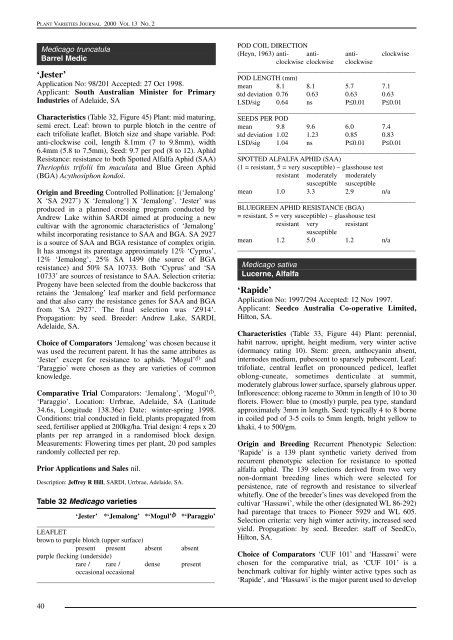52. Volume 13- Number 2 - IP Australia
52. Volume 13- Number 2 - IP Australia
52. Volume 13- Number 2 - IP Australia
You also want an ePaper? Increase the reach of your titles
YUMPU automatically turns print PDFs into web optimized ePapers that Google loves.
PLANT VARIETIES JOURNAL 2000 VOL <strong>13</strong> NO. 2<br />
Medicago truncatula<br />
Barrel Medic<br />
‘Jester’<br />
Application No: 98/201 Accepted: 27 Oct 1998.<br />
Applicant: South <strong>Australia</strong>n Minister for Primary<br />
Industries of Adelaide, SA<br />
Characteristics (Table 32, Figure 45) Plant: mid maturing,<br />
semi erect. Leaf: brown to purple blotch in the centre of<br />
each trifoliate leaflet. Blotch size and shape variable. Pod:<br />
anti-clockwise coil, length 8.1mm (7 to 9.8mm), width<br />
6.4mm (5.8 to 7.5mm), Seed: 9.7 per pod (8 to 12). Aphid<br />
Resistance: resistance to both Spotted Alfalfa Aphid (SAA)<br />
Theriophis trifolii fm maculata and Blue Green Aphid<br />
(BGA) Acythosiphon kondoi.<br />
Origin and Breeding Controlled Pollination: [(‘Jemalong’<br />
X ‘SA 2927’) X ‘Jemalong’] X ‘Jemalong’. ‘Jester’ was<br />
produced in a planned crossing program conducted by<br />
Andrew Lake within SARDI aimed at producing a new<br />
cultivar with the agronomic characteristics of ‘Jemalong’<br />
whilst incorporating resistance to SAA and BGA. SA 2927<br />
is a source of SAA and BGA resistance of complex origin.<br />
It has amongst its parentage approximately 12% ‘Cyprus’,<br />
12% ‘Jemalong’, 25% SA 1499 (the source of BGA<br />
resistance) and 50% SA 10733. Both ‘Cyprus’ and ‘SA<br />
10733’ are sources of resistance to SAA. Selection criteria:<br />
Progeny have been selected from the double backcross that<br />
retains the ‘Jemalong’ leaf marker and field performance<br />
and that also carry the resistance genes for SAA and BGA<br />
from ‘SA 2927’. The final selection was ‘Z914’.<br />
Propagation: by seed. Breeder: Andrew Lake, SARDI,<br />
Adelaide, SA.<br />
Choice of Comparators ‘Jemalong’ was chosen because it<br />
was used the recurrent parent. It has the same attributes as<br />
‘Jester’ except for resistance to aphids. ‘Mogul’ A and<br />
‘Paraggio’ were chosen as they are varieties of common<br />
knowledge.<br />
Comparative Trial Comparators: ‘Jemalong’, ‘Mogul’ A ,<br />
‘Paraggio’. Location: Urrbrae, Adelaide, SA (Latitude<br />
34.6s, Longitude <strong>13</strong>8.36e) Date: winter-spring 1998.<br />
Conditions: trial conducted in field, plants propagated from<br />
seed, fertiliser applied at 200kg/ha. Trial design: 4 reps x 20<br />
plants per rep arranged in a randomised block design.<br />
Measurements: Flowering times per plant, 20 pod samples<br />
randomly collected per rep.<br />
Prior Applications and Sales nil.<br />
Description: Jeffrey R Hill, SARDI, Urrbrae, Adelaide, SA.<br />
Table 32 Medicago varieties<br />
‘Jester’ *‘Jemalong’ *‘Mogul’ A *‘Paraggio’<br />
____________________________________________________<br />
LEAFLET<br />
brown to purple blotch (upper surface)<br />
present present absent absent<br />
purple flecking (underside)<br />
rare / rare / dense present<br />
occasional occasional<br />
____________________________________________________<br />
POD COIL DIRECTION<br />
(Heyn, 1963) anti- anti- anti- clockwise<br />
clockwise clockwise clockwise<br />
____________________________________________________<br />
POD LENGTH (mm)<br />
mean 8.1 8.1 5.7 7.1<br />
std deviation 0.76 0.63 0.63 0.63<br />
LSD/sig 0.64 ns P≤0.01 P≤0.01<br />
____________________________________________________<br />
SEEDS PER POD<br />
mean 9.8 9.6 6.0 7.4<br />
std deviation 1.02 1.23 0.85 0.83<br />
LSD/sig 1.04 ns P≤0.01 P≤0.01<br />
____________________________________________________<br />
SPOTTED ALFALFA APHID (SAA)<br />
(1 = resistant, 5 = very susceptible) – glasshouse test<br />
resistant moderately moderately<br />
susceptible susceptible<br />
mean 1.0 3.3 2.9 n/a<br />
____________________________________________________<br />
BLUEGREEN APHID RESISTANCE (BGA)<br />
= resistant, 5 = very susceptible) – glasshouse test<br />
resistant very resistant<br />
susceptible<br />
mean 1.2 5.0 1.2 n/a<br />
____________________________________________________<br />
Medicago sativa<br />
Lucerne, Alfalfa<br />
‘Rapide’<br />
Application No: 1997/294 Accepted: 12 Nov 1997.<br />
Applicant: Seedco <strong>Australia</strong> Co-operative Limited,<br />
Hilton, SA.<br />
Characteristics (Table 33, Figure 44) Plant: perennial,<br />
habit narrow, upright, height medium, very winter active<br />
(dormancy rating 10). Stem: green, anthocyanin absent,<br />
internodes medium, pubescent to sparsely pubescent. Leaf:<br />
trifoliate, central leaflet on pronounced pedicel, leaflet<br />
oblong-cuneate, sometimes denticulate at summit,<br />
moderately glabrous lower surface, sparsely glabrous upper.<br />
Inflorescence: oblong raceme to 30mm in length of 10 to 30<br />
florets. Flower: blue to (mostly) purple, pea type, standard<br />
approximately 3mm in length. Seed: typically 4 to 8 borne<br />
in coiled pod of 3-5 coils to 5mm length, bright yellow to<br />
khaki, 4 to 500/gm.<br />
Origin and Breeding Recurrent Phenotypic Selection:<br />
‘Rapide’ is a <strong>13</strong>9 plant synthetic variety derived from<br />
recurrent phenotypic selection for resistance to spotted<br />
alfalfa aphid. The <strong>13</strong>9 selections derived from two very<br />
non-dormant breeding lines which were selected for<br />
persistence, rate of regrowth and resistance to silverleaf<br />
whitefly. One of the breeder’s lines was developed from the<br />
cultivar ‘Hassawi’, while the other (designated WL 86-292)<br />
had parentage that traces to Pioneer 5929 and WL 605.<br />
Selection criteria: very high winter activity, increased seed<br />
yield. Propagation: by seed. Breeder: staff of SeedCo,<br />
Hilton, SA.<br />
Choice of Comparators ‘CUF 101’ and ‘Hassawi’ were<br />
chosen for the comparative trial, as ‘CUF 101’ is a<br />
benchmark cultivar for highly winter active types such as<br />
‘Rapide’, and ‘Hassawi’ is the major parent used to develop<br />
40

















